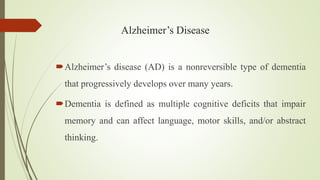
nuero mw.pptx
- 1. Alzheimer’s Disease Alzheimer’s disease (AD) is a nonreversible type of dementia that progressively develops over many years. Dementia is defined as multiple cognitive deficits that impair memory and can affect language, motor skills, and/or abstract thinking.
- 2. Risk Factors Advanced age Genetic predisposition Environmental agents (herpes virus, metal, or toxic waste) Previous head injury Sex (female)
- 3. Clinical manifestation AD is characterized by Memory Loss, Problems With Judgment Changes In Personality Forgetfulness Difficulty in social or work situations Loss of awareness of recent events and surroundings movement is lost › Unrecognizable speech(at sever stage)
- 4. Tests Genetic testing for the presence of apolipoprotein E can determine if late- onset dementia is due to AD. There is no definitive diagnostic procedure, except brain tissue examination upon death. Magnetic resonance imaging (MRI), computed tomography (CT) and electroencephalogram (EEG) may be performed to rule out other possible causes of findings
- 5. Medications Most medications for clients who have dementia attempt to target behavioral and emotional problems, such as anxiety and depression. These medications include antipsychotics, antidepressants, and anxiolytics. Clients receiving these medications should be closely monitored for adverse effects. AD medications temporarily slow the course of the disease and do not work for all clients. If a client fails to improve with one medication, a trial of one of the other medications is warranted.
- 6. Nursing Care Assess cognitive status, memory, judgment, and personality changes. Provide a safe environment. Keep the client on a sleeping schedule and monitor for irregular sleeping patterns. Provide verbal and nonverbal ways to communicate with the client. Offer snacks or finger foods if the client is unable to sit for long periods of time. Check the client’s skin weekly for breakdown.
- 7. Cont.… Offer varied environmental stimulations, such as walks, music, or craft activities. Keep a structured environment and introduce change gradually (client’s daily routine or a room change). Use a calendar to assist with orientation. Use short directions when explaining an activity or care the client needs, such as a bath.
- 8. Cerebral Aneurysm A cerebral aneurysm is a balloon-like out-pouching caused by a congenital or developed weakness in a cerebral artery. Trauma, infection, or vessel wall lesions due to atherosclerosis can all lead to the development of an aneurysm. Increased pressure within the vessel lumen may cause the aneurysm to rupture, causing significant intracranial bleeding
- 10. SIGNS AND SYMPTOMS Asymptomatic until rupture Very bad headache due to hemorrhage and increased intracranial pressure Decreased level of consciousness due to increased intracranial pressure from blood accumulating within the brain
- 11. INTERPRETING TEST RESULTS Angiogram highlights the aneurysm due to structural abnormality. CT scan shows the aneurysm unless it is very small. Digital subtraction angiography shows the detail of the vasculature— abnormal structure. Diffusion/perfusion MRI or MRA (magnetic resonance angiography) shows vessel structure.
- 12. Medical TREATMENT Surgical repair of the aneurysm. Administer corticosteroid drugs to reduce inflammation: Administer anticonvulsant drugs to reduce seizure risk due to irritation of brain:
- 13. NURSING INTERVENTION Monitor the patient’s neurological function for changes—typically use Glasgow Coma Scale or similar tool to grade response to stimuli/ Monitor vital signs for changes—widened pulse pressure with bradycardia indicative of increased intracranial pressure. Explain to the patient: Needs for homecare. When to call healthcare provider.
- 15. Gullian – barre syndrome (polyneuritis)